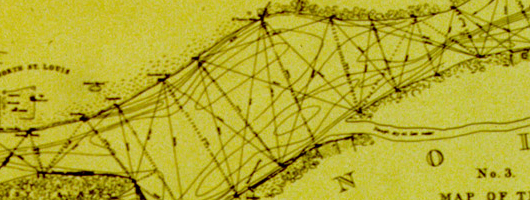
History
The advent of the steamboat in the early 19th century brought about a dramatic change in travel and commerce along our nation's inland waterways. With increased traffic, safety on the river became a vital concern for the crews, passengers, and cargo aboard the vessels (Figure 1-1). Early river engineering design was employed on major rivers such as the Mississippi and Missouri Rivers to ensure a safer, more dependable and deeper navigation channel. River engineering design involved the layout and construction of dike and revetment works, including willow mattress construction for the stabilization of eroding banks in bends, and wooden pile dike construction, for the management of sediment within the channel.
These early designs (Figure 1-2) relied heavily upon intuition, experience, and prior European construction. Learning from the mistakes and successes of this early American river engineering, a historical knowledge base was established. The knowledge base did not contain equations or complex design procedures. Instead, it involved real world results of both successful designs and failures in the actual river. A desire to work with the forces of nature rather than contend against them was always the underlying premises for design. As time passed, more experience and knowledge was acquired.
The problems that river engineers have dealt with in the past continue today. Frequent dredging, at great expense to the taxpayer, has been required in river reaches that repetitively shoal with sediment. River engineers have been responsible for designing solutions to dredging in an environmentally sensitive manner. River engineers have also been responsible for solving navigation alignment problems, such as in reaches upstream of bridges, harbors, locks and dams, etc. There are numerous bridge crossings, harbor entrances, and locks and dams on the rivers of the Inland Waterway Navigation System in the U.S. Normally, the river engineer's task has been to ensure a safe alignment or approach of the navigation channels through these types of structures.
Today, things have not radically changed from the way early river engineering was performed. Past historical knowledge combined with intuition and experience is still at the forefront of design (Figure 1-3). However, what has changed is the amount, type, and detail of river data now available for the engineer's use. Within the last decade, new technologies such as the multi-beam hydrographic survey system for the collection of high-resolution bathymetry, and the acoustic Doppler current systems for the measurement of flow, have immensely advanced the engineer's ability to "read" the river.



